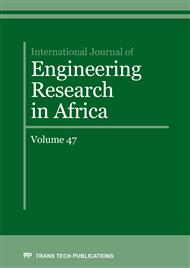[1]
S. Y. Kumcu, M. A. Kokpinar, and M. Gogus, Scour protection around vertical-wall bridge abutments with collars,, KSCE J. Civ. Eng., vol. 18, no. 6, (2014), 1884–1895.
DOI: 10.1007/s12205-014-0245-4
Google Scholar
[2]
D. S. Jeng, D. H. Cha, and M. Blumenstein, Neural Network model for the prediction of wave-induced liquefaction potential in a porous seabed,, Ocean Eng., vol. 31, no. 17–18, (2004), 2073–(2086).
DOI: 10.1016/j.oceaneng.2004.05.006
Google Scholar
[3]
S. Akib, N. L. Mamat, H. Basser, and A. Jahangirzadeh, Reducing Local Scouring at Bridge's Piles using Collars and Geobags,, Sci. world J., vol. 2014, (2014), 1–7.
DOI: 10.1155/2014/128635
Google Scholar
[4]
E. Adel and S. Rudolf, Rapid assessment of foundation scour using the dynamic features of bridge superstructure,, Constr. Build. Mater., vol. 50, (2014), 42–49.
DOI: 10.1016/j.conbuildmat.2013.08.079
Google Scholar
[5]
L. Wang, B. W. Melville, and D. Guan, Effects of Upstream Weir Slope on Local Scour at Submerged Weirs,, J. Hydraul. Eng., vol. 144, no. 3, (2018).
DOI: 10.1061/(asce)hy.1943-7900.0001431
Google Scholar
[6]
L. Wang, B. W. Melville, D. Guan, and C. N. Whittaker, Local Scour at Downstream Sloped Submerged Weirs,, J. Hydraul. Eng., vol. 144, no. 8, (2018).
DOI: 10.1061/(asce)hy.1943-7900.0001492
Google Scholar
[7]
L. Wang, B. W. Melville, C. N. Whittaker, and D. Guan, Effects of a downstream submerged weir on local scour at bridge piers,, J. Hydro-environment Res., vol. 20, (2018), 101–109.
DOI: 10.1016/j.jher.2018.06.001
Google Scholar
[8]
Y. Yang, B. W. Melville, D. M. Sheppard, and A. Y. Shamseldin, Clear-water local scour at skewed complex bridge piers,, J. Hydraul. Eng., vol. 144, no. 6, (2018), 1–32.
DOI: 10.1061/(asce)hy.1943-7900.0001458
Google Scholar
[9]
A. H. Cardoso and R. Bettes, Effect of time and channel geometry on scour at bridge abutments,, J. Hydraul. Eng., vol. 125, no. 4, (1999), 388–399.
DOI: 10.1061/(asce)0733-9429(1999)125:4(388)
Google Scholar
[10]
X. Yan, S. Yu, and Y. Aijun, Dynamic interaction between bridge pier and its large pile foundation considering earthquake and scour depths,, Adv. Struct. Eng., vol. 19, no. 9, (2016), 1390–1402.
DOI: 10.1177/1369433216642077
Google Scholar
[11]
K. K. Mohammad, M. Mohd, and A. Javed, Bridge Pier Scour: A review of mechanism, causes and geotechnical aspects,, in AGE AMU ALIGARH, (2016), 1–6.
Google Scholar
[12]
L. Fayun, Z. Hao, and H. Maosong, Influence of flood-induced scour on dynamic impedances of pile groups considering the stress history of undrained soft clay,, Soil Dyn. Earthq. Eng., vol. 96, (2017), 76–88.
DOI: 10.1016/j.soildyn.2017.02.009
Google Scholar
[13]
J. P. Luke, G. Kenneth, and R. Cormac, Sensitivity studies on scour detection using vibration-based systems,, Transp. Res. Procedia, vol. 14, (2016), 3982–3989.
DOI: 10.1016/j.trpro.2016.05.495
Google Scholar
[14]
J. Choudhury and A. Hasnat, Bridges collapses around the world: Causes and mechanisms,, in IABSE-JSCE Joint Conference on Advances in Bridge Engineering III, (2015).
Google Scholar
[15]
B. Ting, S. R. Andrew, V. Stanley, S. Ye, Z. Chao, and L. Zhen, Critical insights for advanced bridge scour detection using the natural frequency,, J. Sound Vib., vol. 386, (2017), 116–133.
DOI: 10.1016/j.jsv.2016.06.039
Google Scholar
[16]
B. Maddison, Scour failure of bridges,, Forensic Eng. Proc. Inst. Civ. Eng., vol. 165, no. FE1, (2012), 39–52.
Google Scholar
[17]
L. J. Prendergast and K. Gavin, A review of bridge scour monitoring techniques,, Journal Rock Mech. Geotech. Eng., vol. 6, (2014), 138–149.
Google Scholar
[18]
B. Luigia, P. Paolo, and D. B. Giuliano, Bridge Pier Scour: A review of process, measurement and estimates,, Environ. Eng. Manag. J., vol. 11, no. 5, (2012), 975–989.
Google Scholar
[19]
B. Melville, The physics of local scour at bridge piers,, in Fourth International Conference on Scour and Erosion, (2008), 28–40.
Google Scholar
[20]
S. M. Bateni, B. S. M, and D. S. Jeng, Neural network and neuro-fuzzy assessment for scour depth around bridge piers,, Eng. Appl. Artif. Intell., vol. 20, no. 3, (2007), 401–414.
DOI: 10.1016/j.engappai.2006.06.012
Google Scholar
[21]
H. N. Breusers, G. Nicollet, and H. W. Shen, Local Scour Around Cylindrical Piers,, J. Hydraul. Res., vol. 15, no. 3, (1977), 211–252.
DOI: 10.1080/00221687709499645
Google Scholar
[22]
S. C. Jain and E. E. Fischer, Scour Around Circular Piers at High Froude Numbers,, (1979).
Google Scholar
[23]
B. W. Melville, Pier and abutment scour: Integrated approach,, J. Hydraul. Eng. ASCE, vol. 123, no. 2, (1997), 125–136.
DOI: 10.1061/(asce)0733-9429(1997)123:2(125)
Google Scholar
[24]
E. V Richardson and S. R. Davis, Evaluating scour at bridges, Fifth Edition,, (2001).
Google Scholar
[25]
R. K. Neerukatti, I. Kim, M. Fard, and A. Chattopadhyay, Prediction of scour depth around bridge piers using Gaussian process,, in Proc. SPIE 8692, Sensors and Smart Structures Technologies for Civil, Mechanical, and Aerospace Systems, (2013), 1–8.
DOI: 10.1117/12.2009901
Google Scholar
[26]
O. R. Dolling and E. A. Varas, Artificial neural networks for streamflow prediction,, J. Hydraul. Res., vol. 40, no. 5, (2002), 547–554.
DOI: 10.1080/00221680209499899
Google Scholar
[27]
M. Buyukyildiz and S. Y. Kumcu, An Estimation of the Suspended Sediment Load Using Adaptive Network Based Fuzzy Inference System, Support Vector Machine and Artificial Neural Network Models,, Water Resour. Manag., vol. 31, no. 4, (2017), 1343–1359.
DOI: 10.1007/s11269-017-1581-1
Google Scholar
[28]
K. A. Dauda, A. N. Babatunde, K. O. Olorede, S. O. Abdulsalam, and O. R. Ogundokun, Effectiveness of contraceptive usage among reproductive ages in Nigeria using Artificial Neural Network (ANN),, Comput. Inf. Syst. J. (University West Scotland), vol. 22, no. 1, (2018), 24–34.
Google Scholar
[29]
K. A. Dauda and W. B. Yahya, Artificial Neural Networks techniques for competing risk modelling of double-blinded randomized clinical trial data,, in Professional Statistical Society of Nigeria proceedings, (2017).
Google Scholar
[30]
M. Zounemat-Kermani, A. A. Beheshti, B. Ataie-Ashtiani, and S. R. Sabbagh-Yazdi, Estimation of Current-Induced Scour Depth around Pile Groups Using Neural Network and Adaptive Neuro-Fuzzy Inference System,, Appl. Soft Comput., vol. 9, (2009), 746–755.
DOI: 10.1016/j.asoc.2008.09.006
Google Scholar
[31]
A. Kaya, Artificial Neural Network Study of Observed Pattern of Scour Depth around Bridge Piers,, Comput. Geotech., vol. 37, 2010, 413–418.
DOI: 10.1016/j.compgeo.2009.10.003
Google Scholar
[32]
T. L. Lee, D. S. Jeng, G. H. Zhang, and J. H. Hong, Neural Network Modeling for Estimation of Scour Depth around Bridge Piers,, J. Hydrodyn., (2007), 378–386.
DOI: 10.1016/s1001-6058(07)60073-0
Google Scholar


